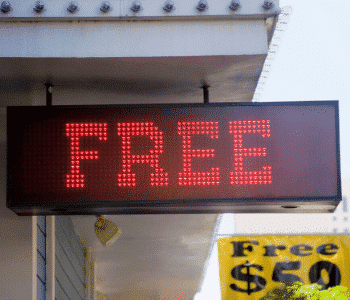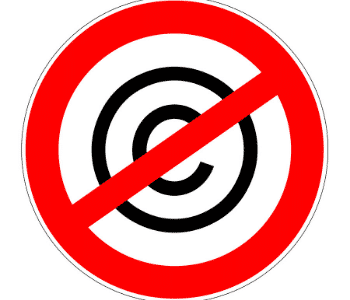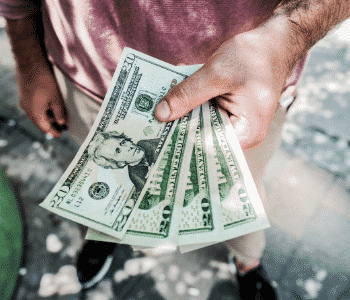The Difference Between ‘Copyright Free’ and ‘Royalty Free’

If you’re looking for images, music, or film clips to use with your content, you’ve likely run across two similar but very different terms: “Copyright Free” and “Royalty Free.”
These terms are used with great confusion online and it gets even more confusing with offers of “No Copyright Music” or “Free to Use” content.
However, the simple truth is that not all free is the same. In fact, not all free is even wholly free. Some “free” things can actually be very expensive.
To understand why we have to look at the two terms and understand how they’re similar, how they’re different and, most importantly, how they are misused.
To that end, here’s a quick dive into two of the most confusing and misused terms in all of copyright.
Copyright Free

“Copyright free”, when taken literally, simply means that the work is “free of copyright”. This would indicate that it is in the public domain. This happens either when a work lapses into the public domain, such as works published on or before 1924, works by the U.S. Federal government or works where the creators have surrendered their copyright.
Legally, with these works, you can do more or less what you want with them. Ethically, attribution may be desirable but it’s not required to avoid a lawsuit. There are functionally no restrictions on what you can do with them including selling them, creating new works based upon them or distributing them broadly online.
However, as simple as it is, this term often gets misused colloquially.
For example, if you search YouTube for “Copyright Free Music” or “No Copyright Music” you will find a large number of tracks that are not actually copyright free. For example, this channel claims to offer “Copyright Free Music” but all of the songs require attribution and the use is limited to YouTube. Further, some tracks can’t even be used in monetized videos.
As such, when approaching work that claims to be “Copyright Free” it’s very important to ensure that it actually is and, if not, to comply with the license terms. Otherwise, you may find out just how not free of copyright the work actually is.
Royalty Free

“Royalty free” simply means that a piece of content is free from royalties, meaning that it is free from ongoing payments.
Often times, when a song is used in a movie or a piece of artwork is featured in a video, the creator will negotiate some form of ongoing payment for the use of that content. That payment is called a royalty.
“Royalty free” simply means that no such ongoing payments are necessary. It does not mean that the work is free or that that aren’t restrictions on its use. For example, a royalty-free stock photography might cost hundreds of dollars to license but will require no additional royalties down the line. After that payment, the image is free to use for as long as the license allows and in the ways it allows.
Royalty-free works can indeed be free. There are many free stock photography websites that allow you to download and use images that you will never have to pay a royalty or a license fee for. That said, these are not public domain or copyright-free images and they have limitations on their license.
For example, Pixabay, a large free stock photo website, bars a variety of uses of the images it hosts including barring direct sale/distribution of the images.
The important thing to remember with royalty-free work is that it refers to the lack of ongoing payments, not the lack of an initial payment and not the lack of limitations on the use of the work. With royalty-free work, always take the time to read the license and follow it carefully.
Why This is Important
The confusion here is understandable. Both “copyright free” and “royalty free” are terms that have a legal meaning but have been altered through casual use. However, this confusion is also potentially dangerous.
For example, many YouTubers have had their channels threatened over the use of stock images or music that they thought they had permission to use but didn’t. Rightsholders are becoming increasingly aggressive and with the rise of bots to find matching content, even obscure infringements are being detected easily.
In general, the best thing that you can do is not seek out “copyright free” or “royalty free” content and, instead, seek out content licensed for whatever you want to do with it. Do you want to use an image on your site? Find a stock photo site that specializes in that. Need background music for a YouTube video? Find a music licensing site for that.
If you need content that you can use without worrying about copyright at all, don’t seek out “copyright free” content and, instead, seek out “public domain” content. While you still need to be careful and ensure that the content is actually public domain, especially if you do not live in the United States, you’re much more likely to get actual copyright free content that way.
As always, be careful about where you get your content from and always read the licenses carefully. A few minutes of time while searching can save you countless headaches down the road.
Bottom Line
With copyright, free does not always equal free and even “copyright free” doesn’t always mean free of copyright.
As such, when you are licensing content to use on your site, in your music or in your videos, you always need to be careful that you are getting the exact license that you need. If you truly need something that is free of copyright, the best bet is to seek out public domain content and not “copyright free” content.
While the changing nature of language is natural and normal, it can become dangerous when casual language assigns different meanings to words than their legal definitions. This is true in many areas of law. For example, the legal definition of assault is very different than the colloquial one.
However, with copyright, these differences are even more impactful. The reason is that there’s already a great deal of confusion about copyright and how it works. When we mix in unclear terms it’s no wonder that many well-meaning people find themselves on the wrong side of a DMCA notice or even a lawsuit.
In the end, the best thing to do is to focus on making sure the content you use is correctly licensed. It really doesn’t take much time but it does require being careful and thinking about these issues in advance.
If you do that, you’ll likely save yourself a great deal of trouble in the future.
Want to Reuse or Republish this Content?
If you want to feature this article in your site, classroom or elsewhere, just let us know! We usually grant permission within 24 hours.
